Eager to stimulate change within your organization? Start embedding “design” as a core competency. “Industrial Design”, “Product Design”, “UX Design”, “Service Design”, “Business Design”, “Design Thinking”, “Design Sprints”. How many fancy terms are there, what’s the difference between them and why should you have to know what they’re all about? Don’t worry about it. In this blog, we’ll clear the clutter in order for you to get a better grip on the design lexicon. From there we’d like to share why we believe ‘design’ is an essential competency to incorporate into teams leading digital transformation. ‘Design’, as a term, has taken several years to evolve from merely being associated with an aesthetic profession to a problem-solving mindset that, when applied effectively, is able to enhance innovation processes within organizations. This blog may not be the first to tell you that. It is, however, important to see how design has taken shape during an era of digitalization to fully understand its relevance today. Digitalization has led to high paced market shifts forcing businesses to rapidly innovate on a continuous basis. Creative problem solvers are needed for organizations to stay in business the day after tomorrow. Applying a design mindset allows businesses to be adaptive and for some to even shape their respective playing fields. Design, long seen as an aesthetic output, has slowly evolved into a strategic approach and has in some cases become a core competency for progressive businesses to disrupt and dominate markets. In this blog, we’ll discuss why that is, and how this came to be.
Where do all these fancy design terms come from?
Out of the aforementioned terms, industrial design is a pretty classic form of design. It came into existence during the industrialization of production and may be seen as the engineering of products for mass-production. Product design, as a subset of industrial design, has a more detailed focus on usability. Where Industrial Design looks at the overall product lifecycle, product design ensures a product is functioning as desired. In the last few decades, industrial design programs have been reshaping themselves based on evolving market needs. Moving from industrialization towards digitalization has widened the scope, forcing design to enter and create new fields that provide room to continuously fuel market growth through digital innovation. Digitalization has led to products becoming in-tangible and businesses becoming more service-oriented. It opened up new dimensions in which design could further evolve into a strategic approach. During this digital transition period, a certain design discipline has been making a massive impact on the way digital minded organizations do business. It has shifted businesses from applying an ‘inside-out’ approach, where products are pushed towards the customer, towards an ‘outside-in’ approach that fits the current era of fast-changing market needs. Thereby allowing these businesses to continuously adjust products, services, and processes to fit the changing needs of the customer. This well-known discipline is called ‘User Experience Design’. Within the design landscape, it has transformed itself from solely being a design term to becoming a key discipline behind the production of customer-centric goods and services. ‘UX design’ experienced an upswing in implementation during the 1990s. Traditionally it’s focus was on the usability of products, thus being a part of product design. With the rise of the internet, UX design became a stand-alone discipline for the design of interface interaction, especially website design. The user-centric approach that UX Design offers started to receive more acknowledgment and slowly became a core competency within software companies. UX Design became a glue between marketing, branding, and graphic/visual design. It allowed these companies to collect richer data on the performance of their products. Making sure they weren’t only effective, but also valuable and easy to use. UX Design thereby transitioned from a focus area within product design, into a full-fledged design discipline mainly incorporated in businesses developing digital interfaces. 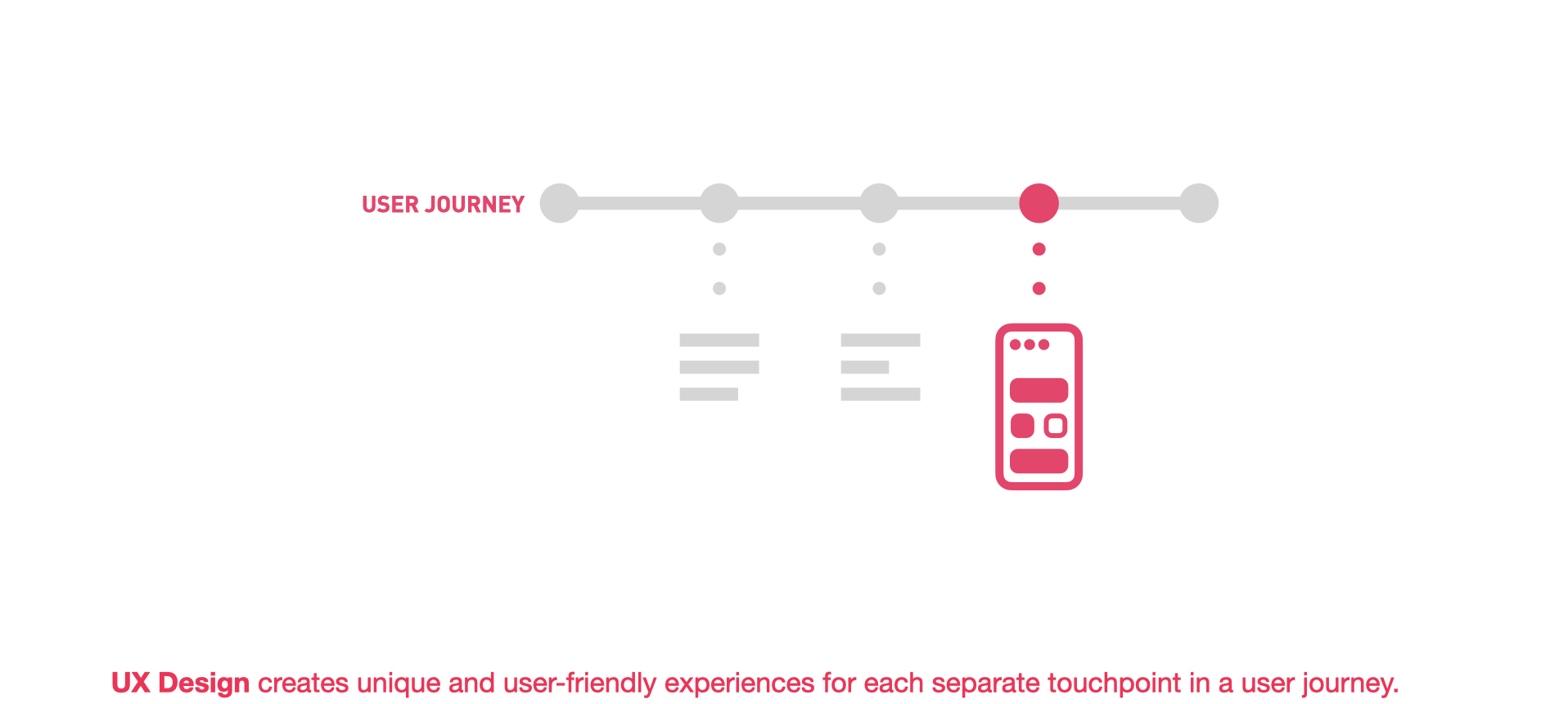 So, for creating one of a kind digital interface experiences, we consult with experts in the field of UX Design. UX designers make sure the experience of using a digital interface is seamless, that all tasks are easy to execute and the experience itself offers the desired emotional value. When creating an entire online experience, there are multiple touchpoints in a user journey where a UX designer does his or her magic. Through user interaction research and quick design iterations, UX designers create fitting digital experiences for customers.When we zoom out and look at who maps out the entire user journey, with all included UX touchpoints, we find the service designer. This type of designer is specialized in drawing out a user journey, encompassing all digital and physical experiences a user has with a service (or product). Service Design, as a discipline, optimizes infrastructure and communication to enrich an end-user’s experience throughout the relationship he or she has with the service provider. By applying tools such as personas, value propositions, user journeys, service blueprints, mock-ups, and interviews a service designer creates an infrastructure that facilitates the desired experience. In addition to the UX designer’s user-centric and iterative approach, a service designer puts significant emphasis on collaboration and holism. In order to shape a service, which is in-tangible and often diffuse, it is key to bring together the network behind it. Through co-creation and solid stakeholder management, service designers are able to make a service tangible. They make sure every unique user experience is connected and part of a larger user engagement strategy.
So, for creating one of a kind digital interface experiences, we consult with experts in the field of UX Design. UX designers make sure the experience of using a digital interface is seamless, that all tasks are easy to execute and the experience itself offers the desired emotional value. When creating an entire online experience, there are multiple touchpoints in a user journey where a UX designer does his or her magic. Through user interaction research and quick design iterations, UX designers create fitting digital experiences for customers.When we zoom out and look at who maps out the entire user journey, with all included UX touchpoints, we find the service designer. This type of designer is specialized in drawing out a user journey, encompassing all digital and physical experiences a user has with a service (or product). Service Design, as a discipline, optimizes infrastructure and communication to enrich an end-user’s experience throughout the relationship he or she has with the service provider. By applying tools such as personas, value propositions, user journeys, service blueprints, mock-ups, and interviews a service designer creates an infrastructure that facilitates the desired experience. In addition to the UX designer’s user-centric and iterative approach, a service designer puts significant emphasis on collaboration and holism. In order to shape a service, which is in-tangible and often diffuse, it is key to bring together the network behind it. Through co-creation and solid stakeholder management, service designers are able to make a service tangible. They make sure every unique user experience is connected and part of a larger user engagement strategy.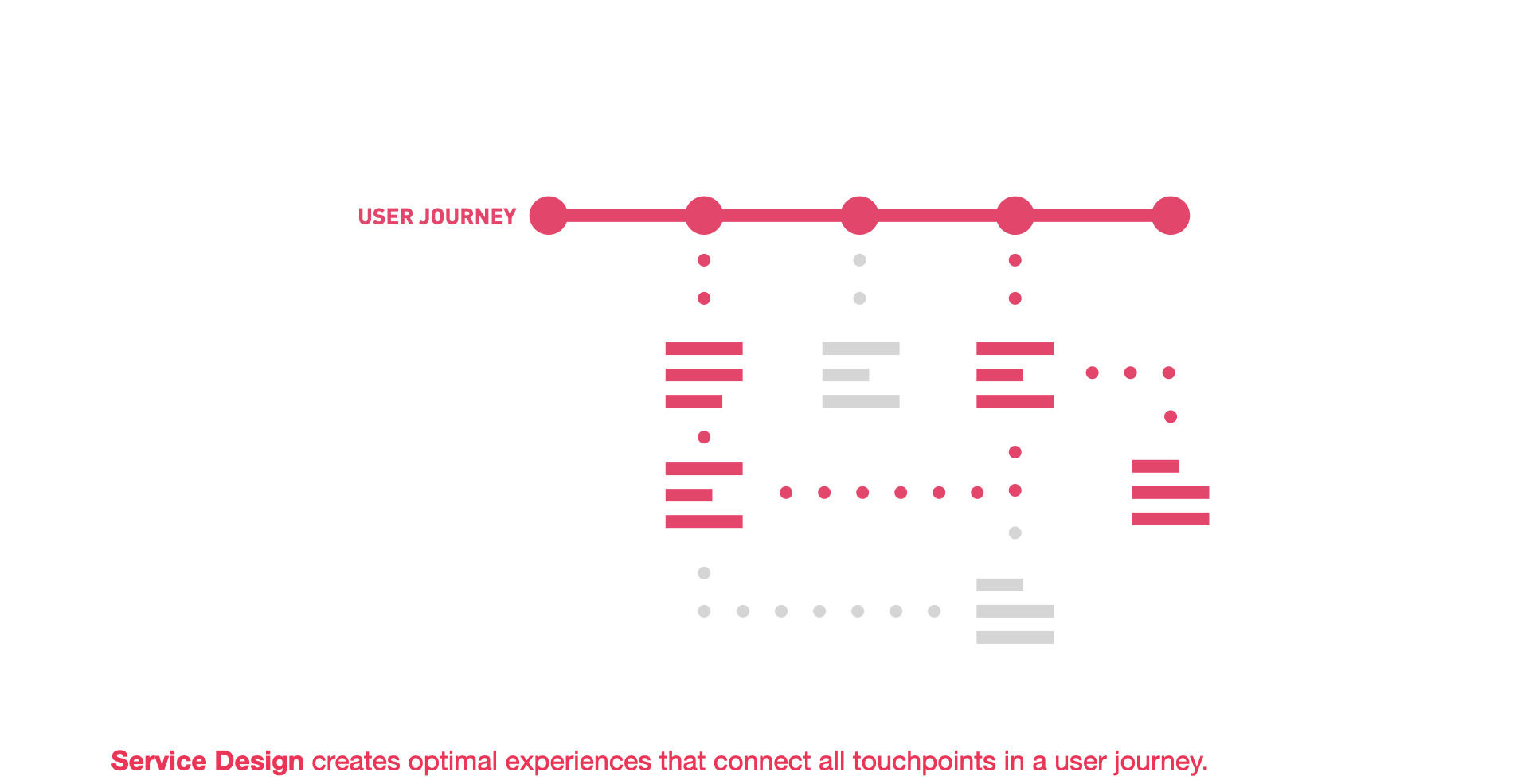 The exact origin of service design is difficult to pinpoint. The term itself traces back to the 1980s when businesses started to become more service-oriented. Marketing teams were in search of ways to visualize the ideal user experience and translate it into an IT & people infrastructure that could facilitate that experience. This led to the introduction of the service blueprint tool, which marketing and business development could use to literally “design a service”. In the last 20 years, service design has grown from a term used within marketing departments into a standalone discipline. Specialized service design consultancies have been founded and various tools and processes have been created to help organizations innovate through design practices. The popularity of UX and service design has helped ‘design’, as a competency, penetrate the walls of traditional organizations. Although not every organization has acknowledged design as the key to becoming customer-centric, it has become clear that creative minds fuel innovation. In order to stimulate and capitalize on creativity, these organizations need to implement a new way of working. A way of working that is created by becoming design-minded.
The exact origin of service design is difficult to pinpoint. The term itself traces back to the 1980s when businesses started to become more service-oriented. Marketing teams were in search of ways to visualize the ideal user experience and translate it into an IT & people infrastructure that could facilitate that experience. This led to the introduction of the service blueprint tool, which marketing and business development could use to literally “design a service”. In the last 20 years, service design has grown from a term used within marketing departments into a standalone discipline. Specialized service design consultancies have been founded and various tools and processes have been created to help organizations innovate through design practices. The popularity of UX and service design has helped ‘design’, as a competency, penetrate the walls of traditional organizations. Although not every organization has acknowledged design as the key to becoming customer-centric, it has become clear that creative minds fuel innovation. In order to stimulate and capitalize on creativity, these organizations need to implement a new way of working. A way of working that is created by becoming design-minded.
Design-driven innovation
The broad range of design practices all intend to innovate within their respective areas. ‘Innovating’ itself has been, and still is, a practice that is difficult for organizations to successfully execute. In recent years, digitalization has been accelerating at a high pace, creating a need to innovate at a similar speed. Innovating means taking risks. Traditional management tends to be quite reserved when it comes to taking risks as it occasionally disturbs daily operations. However, in our current era, when a company is too obsessed with its current operations, it becomes blind for market disruption. More than ever the need to innovate has become crystal clear. The fact that the average lifespan of an S&P 500 company has dropped from 60 to under 20 years since the 1950s substantiates the urge for businesses to innovate by means of digital transformation. Design, as a competency, can offer organizations structure and guidance during their digital transformation. In order to achieve change, abstract ideas need to be made concrete. Design practices thus need to be tangible for implementation. This is where terms such as ‘design thinking’ and ‘design sprints’ come into play. These design terms aren’t disciplines, but methods that teams can apply to follow a structured process for optimization and renewal. ‘Design thinking’ is a method to help businesses solve ill-defined problems. It follows 5 stages; empathize, define, ideate, prototype & test, which can be executed continuously in order to validate assumptions. It allows teams to tackle challenges and generate solutions by iterating quickly and fluently. Design thinking has roughly the same timeline as UX and service design. Dating back to the 1980s and experiencing a growth in popularity around the start of the 21st century. This is not a coincidence since design thinking can be seen as the bedrock for modern-day design disciplines. Each discipline follows the same 5 stages in chronological order and applies a high level of human empathy. It offers organizations the ability to experiment and innovate in an agile way. This is why it makes ‘design’, in its most basic form, a competency worth investing in.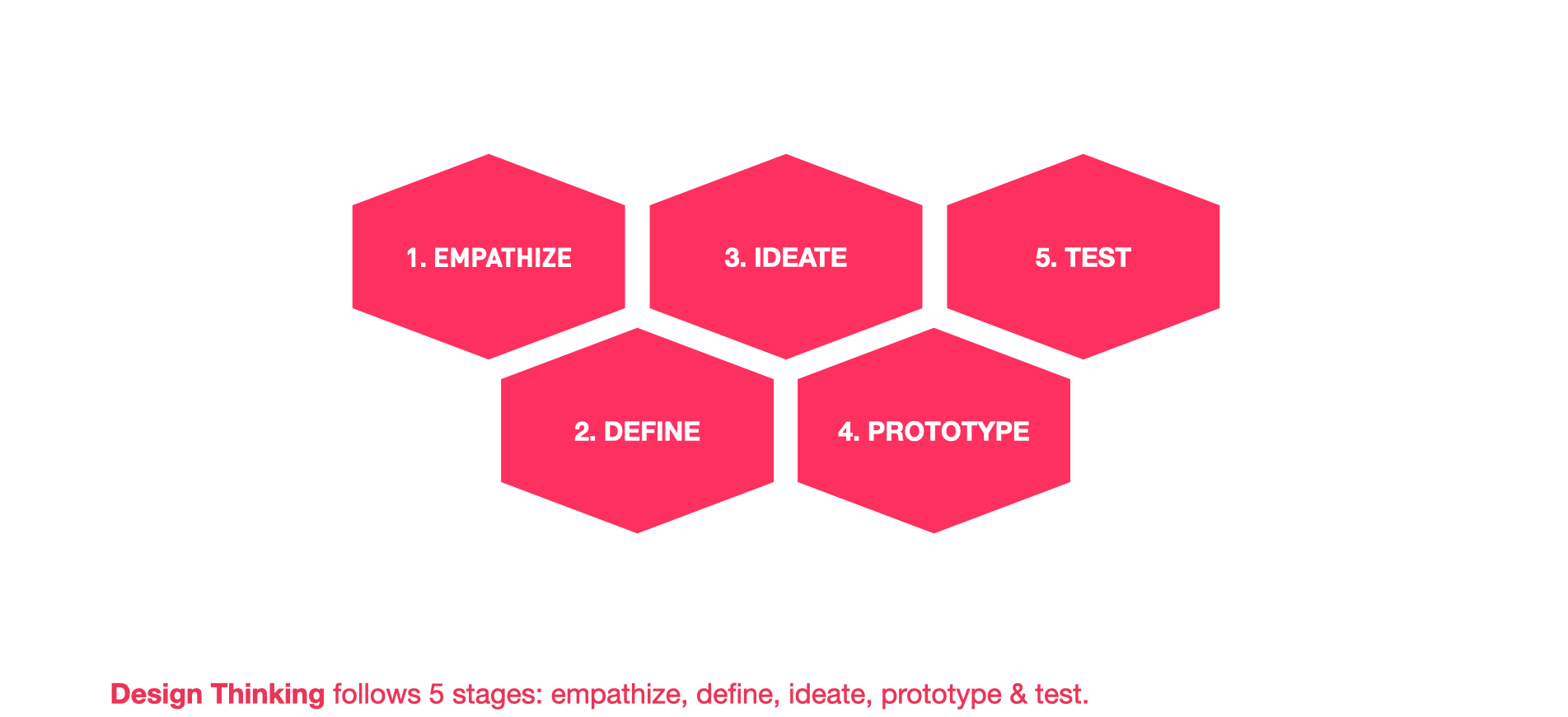 Once progressive organizations started adopting a design mindset and incorporating the required tools and methods to stimulate an agile way of innovating, more and more businesses started to follow the trend. However, simply copying methods and hiring creative minds doesn’t automatically contribute to the expected innovative results. While design, as a term, has gained enormous popularity in recent years, with it also came a lot of doubt and pessimism. A significant number of businesses, wanting to bandwagon on the trend, have only sparsely applied ‘design’ in their rush to innovate. These businesses often lag behind on digital transformation and tend to be quite impatient for the desired output. When ‘design’ doesn’t generate the expected ROI, it gets criticized. What is misunderstood here is that ‘design’ isn’t simply applied, it has to be embedded into an organization. This takes time and perseverance. It is absolutely crucial to understand the core values so that the right environment is created for the tools and methods to work. Recently numerous design-oriented consultancies have been introducing the ‘design sprint’. It creates a very low threshold for organizations, experiencing a moderate digital renewal, to start experimenting with ideas. A design sprint is an agile method that compresses the design thinking stages into a very practical and structured form. It allows teams to generate and validate concepts within just 5 days. Although these 5 energetic days require a high commitment and focus, the investment is relatively low compared to teams struggling with different tools and methods for weeks on end. With a team of 4 to 6 people, ideas are generated, prototyped, and tested with actual users. A process that would normally take several weeks to complete now delivers results in just a single week. This is possible because the entire week is built up of exercises that follow the design way of thinking. Team members are encouraged to embrace ambiguity instead of avoiding it. A design sprint breaks the unhealthy habit of overanalyzing ideas and scenarios. This is why design sprints have recently become such a popular method. Businesses now dare to apply ‘design’ for just a week, because the design sprint output exceeds its initial investment.
Once progressive organizations started adopting a design mindset and incorporating the required tools and methods to stimulate an agile way of innovating, more and more businesses started to follow the trend. However, simply copying methods and hiring creative minds doesn’t automatically contribute to the expected innovative results. While design, as a term, has gained enormous popularity in recent years, with it also came a lot of doubt and pessimism. A significant number of businesses, wanting to bandwagon on the trend, have only sparsely applied ‘design’ in their rush to innovate. These businesses often lag behind on digital transformation and tend to be quite impatient for the desired output. When ‘design’ doesn’t generate the expected ROI, it gets criticized. What is misunderstood here is that ‘design’ isn’t simply applied, it has to be embedded into an organization. This takes time and perseverance. It is absolutely crucial to understand the core values so that the right environment is created for the tools and methods to work. Recently numerous design-oriented consultancies have been introducing the ‘design sprint’. It creates a very low threshold for organizations, experiencing a moderate digital renewal, to start experimenting with ideas. A design sprint is an agile method that compresses the design thinking stages into a very practical and structured form. It allows teams to generate and validate concepts within just 5 days. Although these 5 energetic days require a high commitment and focus, the investment is relatively low compared to teams struggling with different tools and methods for weeks on end. With a team of 4 to 6 people, ideas are generated, prototyped, and tested with actual users. A process that would normally take several weeks to complete now delivers results in just a single week. This is possible because the entire week is built up of exercises that follow the design way of thinking. Team members are encouraged to embrace ambiguity instead of avoiding it. A design sprint breaks the unhealthy habit of overanalyzing ideas and scenarios. This is why design sprints have recently become such a popular method. Businesses now dare to apply ‘design’ for just a week, because the design sprint output exceeds its initial investment.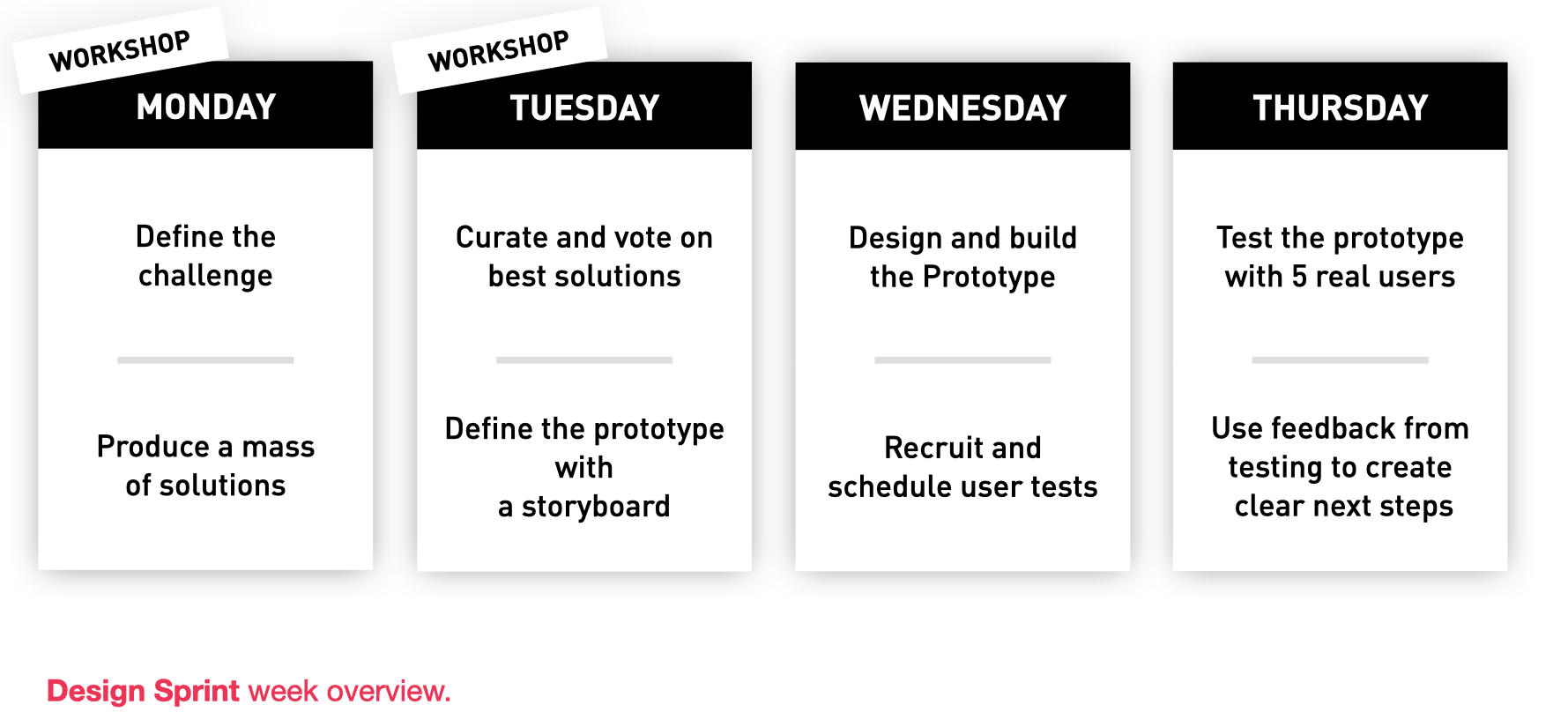
Design’s move into business strategy
In recent years it has become clear for progressive organizations that, in order to stay relevant in a constantly changing environment, ‘design’ should be embedded as a core competency for fueling innovation processes. ‘Design’ firstly ensures that a business knows what their customers want and what they are currently experiencing. Secondly, it provides a new creative, and agile way of problem-solving. The numbers shown in design research are convincing and support this. McKinsey’s research (2018), for instance, depicts how design-minded organizations are outperforming those who aren’t. Based on defined “design index” scores measured across 300 publicly listed companies, design-oriented businesses outperform industry benchmarks roughly two to one on the axis of generated revenue and total returns to shareholders. What these organizations understand very well is that ‘design’ shouldn’t be a siloed function, but rather a shared competency. Although specific design disciplines each offer a unique approach to enhance customer value, they themselves do not make an organization design-minded. To achieve this, every expertise needs to apply a design-minded way of problem-solving. Entire teams, from developers to analysts, should work in a quick iterative way and create room for exploration beyond the confined boundaries of defined playing fields. Once successfully embedded, teams can autonomously solve complex problems without taking on large investment risks. They can explore, define, experiment, and validate ideas in weeks instead of months. Design, as a competency, makes organizations innovate faster with less risk. Design offers more than a customer-centric approach to increase the value of existing propositions. It provides guidance for the creation of new business ventures when teams find themselves in unknown territory. This is where ‘Business Design’, a relatively new discipline yet to be fully defined, comes into play. It aims to be an effective asset within teams developing new business propositions and strategies. Business design takes a holistic approach in designing for business viability. It combines design methods and analytical skills, thereby bridging customer desirability and business viability. By providing the right management tools, business design can transform organizations that tend to be reactive to change, to organizations that use ‘change’ as their fuel to grow. Business design distinguishes itself from strategy consulting in its approach. Like strategy consultants, business designers utilize their analytical ability to uncover potential value, but only to a degree to which it does not clog the design process. The approach is practical and is, like other design disciplines, based on human empathy. From this viewpoint, it may seem similar to service design. The key difference here is that one designs mainly for desirability and the other more for viability and feasibility. Service design is user-centric, whereas business design is more stakeholder-centric. A service designer increases business value by creating optimal user experiences. In this design process, the service designer engages the necessary stakeholders to ensure that optimal experience can be facilitated. Business design, on the other hand, focuses on the creation of the business proposition itself. A win-win-win scenario has to be designed that benefits each link in the value chain. User experience is not the end goal, but rather a variable that determines the viability of the proposition. A business designer looks into user desirability, but less thoroughly than a service designer does. In addition to mock-up prototypes and service blueprints, business designers create output in the form of business models, financial prototypes, and go-to-market plans. The priority of the research output lies in the viability and scalability of the model. Business designers make abstract concepts tangible in a quantitative manner in order to create stakeholder support throughout an organization.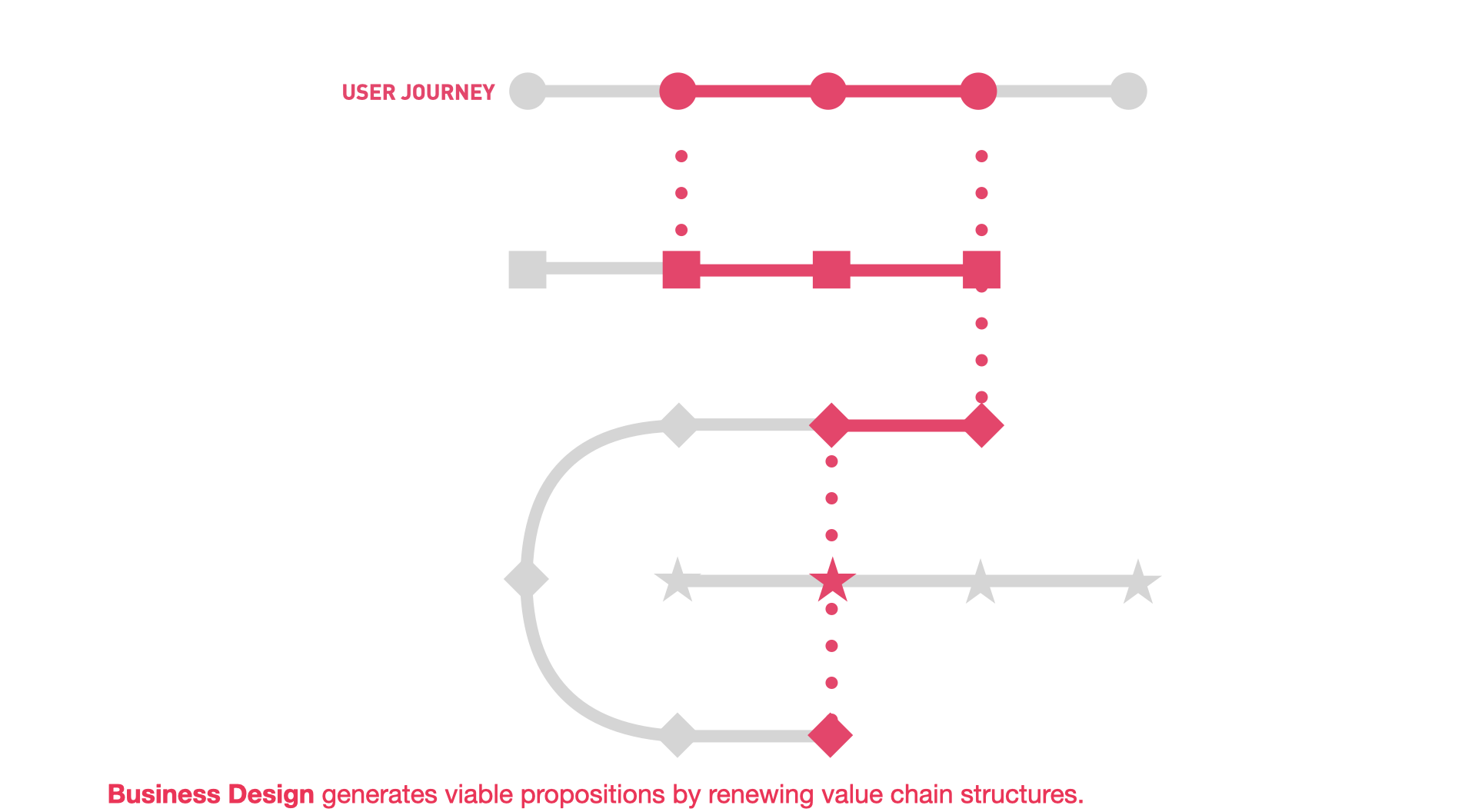
Start embedding design today
In a world where digital disruption has lowered the threshold for new entrants to reshape markets and gain significant market share, design seems to have slowly earned its board seat. Incumbents are not only in need of start-up-like agility, but also crave for a high dose of abstract problem-solving. A company’s operational excellence can ensure a dominant position today, but getting comfortable in the now might lead to missing the boat tomorrow. Progressive organizations see the importance of simultaneously fuelling exploitative and explorative businesses. Successfully executing an ambidextrous strategy, however, remains to be a difficult task. It will take courage and commitment to continuously invest in the development of truly transformational innovation. To encourage innovation, start by evaluating to which degree ‘design’ is currently embedded within your organization. Dissect the company strategy; what is the purpose behind the strategy? What makes it unique from a customer-centric perspective? How is the purpose communicated internally and externally? What value will it create in the near future? Which milestones must be reached this year, next year and even 5 to 8 years from now? Create a fitting culture; does the company culture resonate with the strategy? Does the purpose trigger a sense of belonging within your organization? Are people encouraged to share and experiment with ideas? Do employees feel supported by management to take calculated risks? How often do teams interact with customers, and in which form? Set-up the necessary infrastructure; can people find and exchange information with one another without bumping into managerial barricades? Does management provide time and resources for experimentation? Does the company currently employ design related expertises? Are there clear outlines on how employees are rewarded based on their time investment and output concerning innovation? Are explorative teams set-up so that they do not interfere with daily operations? Integrate effective tools and methods; which tools and methods are used for experimentation? Can they be implemented organization wide? Have they become a standard? Is there a learning curve involved? Have these tools and methods contributed to the desired outputs?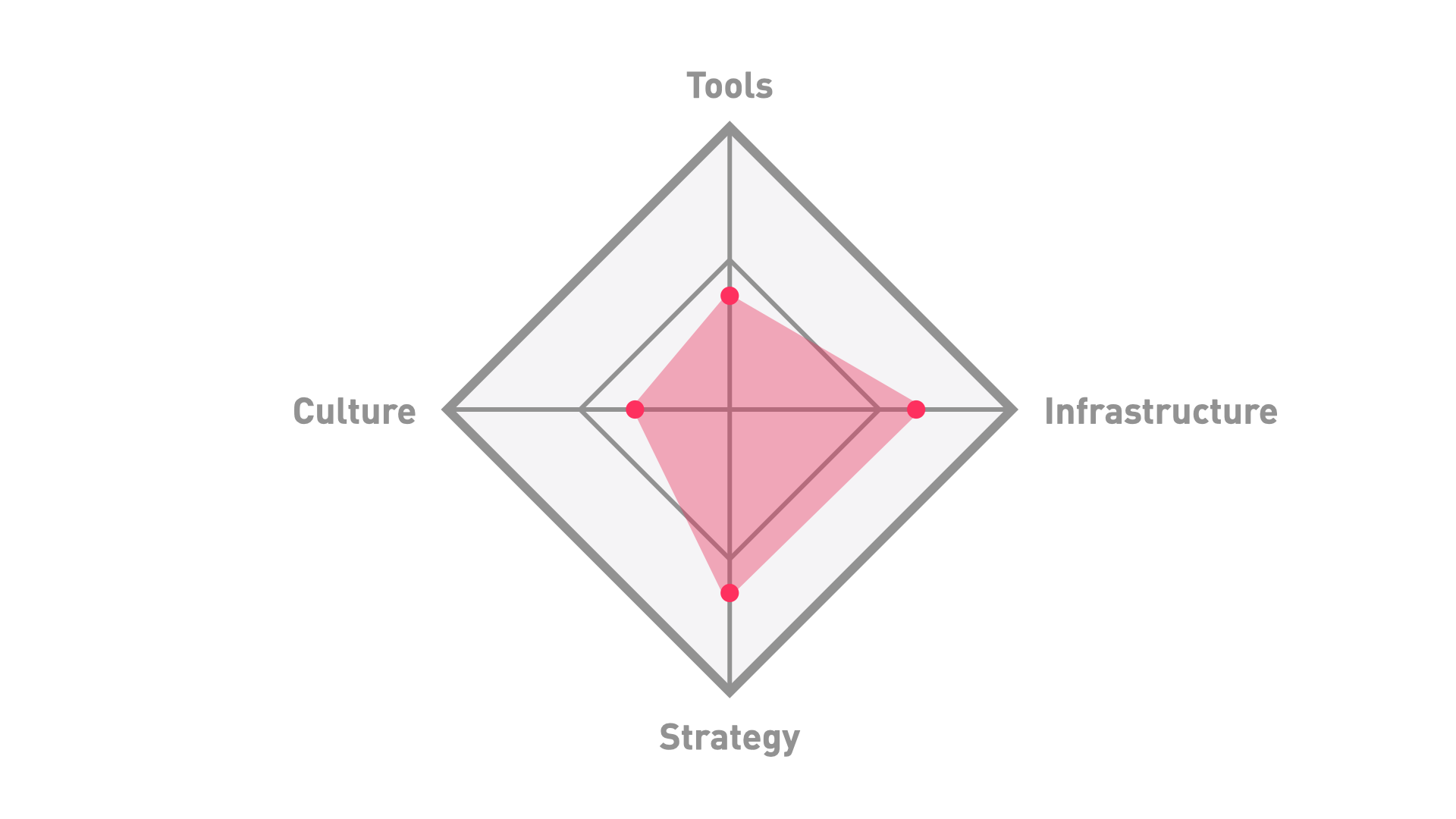 Determine how well your organization scores on these factors. Where do you believe improvements can be made? What has previously been done that has or has not yet generated the expected results? On which axes lie quick wins for your team, department or organization? By implementing new ways of working based on these four factors, you can stimulate change. During that transition, whether big or small, design offers guidance in finding a balanced fit for your organization.
Determine how well your organization scores on these factors. Where do you believe improvements can be made? What has previously been done that has or has not yet generated the expected results? On which axes lie quick wins for your team, department or organization? By implementing new ways of working based on these four factors, you can stimulate change. During that transition, whether big or small, design offers guidance in finding a balanced fit for your organization.
Take the leap with Netvlies.
In co-creation, we help organizations transform today’s needs into future-proof businesses. Whether it’s a robust application or new venture project, our strategy, marketing, and development teams work closely together to create the digital solutions your business desires. Curious to see how we tackle a wide range of business challenges? Get in touch!